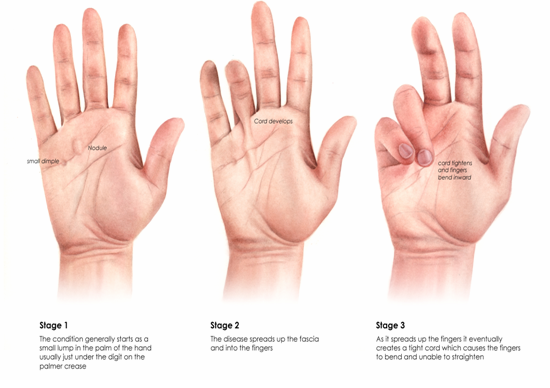What is a Dupuytren's contracture?
Dupuytren's contracture, occasionally called Dupuytren's disease, is a thickening and contraction of the palmar fascia, the fibrous bands on the palms of your hands. This condition was named after Baron Dupuytren (1777-1835), surgeon of Louis the 18th and Charles the 10th. He reported the first account of the disease in 1831. With Dupuytren’s contractures, the connective tissue in your hands becomes extremely thick, causing your fingers to curl inward; especially your ring finger and little finger.
This condition usually begins as a tender lump or nodule in the palm of your hand. Over time, months or years, this area thickens, restricting motion and function. As the condition progresses the individual’s fingers will bend inward towards the palm of the hand.
After the initial stage, Dupuytren’s contracture is not typically painful. Functional impairment becomes the main problem. The degree of the contracture will vary from mild to disabling.
The exact cause (etiology) of Dupuytren’s contracture is often not known. Dupuytren’s is more predominant in smokers, diabetics, epileptics, liver cirrhosis patients, vascular disease patients, and alcoholics. There are also indications of a genetic factor, this condition is more predominant in certain families. Men are also more prone to this condition than women, and persons of European descent have higher incidences (Scandinavian, Irish, or Eastern European ancestry).
From a biomechanical perspective an increase in Dupuytren’s contraction is seen in some individuals who have experienced physical trauma or after performing tasks that require repetitive motion.
Surgical procedures - Sometimes the Dupuytren’s contracture is so severe that surgery is necessary. In these cases there are three options:
- Open fasciotomy: Fasciotomy is the process of cutting the thickened tissue (fascia). In this procedure the overlying skin is cut open, and the thickened tissue is cut out. This procedure is done under local anesthetic in an outpatient clinic.
- Needle fasciotomy: This procedure is also called needle aponeurotomy. In this procedure a fine needle is pushed through the contracture to release the thickened skin. Essentially the needle is used like a saw to release the thickened tissue. This procedure is also done under local anesthetic in an outpatient clinic. Needle fasciotomy is an often recommended procedure. If you are opting for this procedure make sure the person performing the fasciotomy has considerable experience.
- Open fasciectomy. This is a more extensive hand operation. In this procedure the thickened tissue is removed. This procedure is done for severe cases but also carries the greatest risks. Sometimes during surgery nerves, tendons or other soft-tissues can be damaged.
Manual Therapy Procedures (Active Release, Graston, Fascial Manipulation)
In most cases, Dupuytren’s contractures can be effectively treated with manual therapy protocols. These treatments are often combined with heat therapy and an intensive program of daily stretching. Because of the thickness of the Dupuytren’s contracture a considerable amount of force is usually needed to address the restriction. If the treatment is performed correctly a considerable amount of relief is usually felt by the patient.
When prescribing exercises for Dupuytren’s you must always take into account the kinetic chain relationships of the structures that are injured! Even though the restrictions may be primary founding the patients hands, other areas may be involved (arm, elbow, shoulders). Exercises should be performed 4-5 times per day or even every hour in severe cases.
If you would like more information or to purchase our books please go to www.releaseyourbody.com .
If you would like information about our clinic in Calgary Alberta please go to www.kinetichealth.ca.
(COPYRIGHT KINETIC HEALTH 2012 – ALL RIGHTS RESERVED)


Thanks for the information... Here people mostly opt for Dupuytren’s Contracture Surgery in AZ.... as we all know Hand surgery especially Dupuytren's contracture surgery requires intensive care. So always choose the best doctor for this.
ReplyDeleteGreat post
ReplyDeleteGraston Near Me